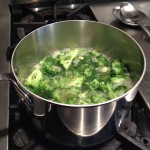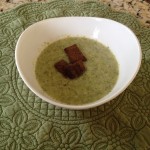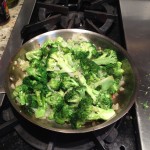This Meatless Monday, we feature recipes for Creamy Broccoli Soup and Easy Broccoli Quiche from our Vermont Fresh: A Fruit and Vegetable Handbook, as well as growing, storage and preparation tips.
Sally Simpson, a volunteer cooking, tasting and testing recipes out of the Vermont Fresh Handbook tested these recipes. Her comments are below in italics.
Background
Broccoli comes to us from the Mediterranean, where it has grown for centuries. It is a member of the Brassica family, meaning that is related to mustards, kale, and cabbage. Indeed, it probably originated from a form of flowering cabbage. Broccoli has been crossed with other plants to create some unique vegetables such as “broccolini” (a cross between broccoli and a Chinese green). Not surprisingly, the tree-shaped broccoli is also closely related to cauliflower. Broccoli heads are collections of tiny, immature flower buds atop branching stems; some types form tight heads, while others are “sprouting” varieties. Italians were the first to truly appreciate broccoli, but the vegetable slowly spread and is now popular worldwide both fresh and frozen.
Growing Tips
Broccoli likes to grow in cooler temperatures, making it a good spring and fall crop. For spring, transplanting is recommended; even though seedlings are hardy, they will grow better if you start them inside 4 weeks before setting out. Broccoli is also a heavy feeder, meaning that you should provide plants with plenty of compost and rotate them around your garden from year to year. Considering that full plants need about 1 square foot each, give seedlings plenty of room. Like its relatives, broccoli is susceptible to attack by cabbage worms, which can be warded off with applications of Bacillus thurengensis, a low-impact pesticide. If you notice the roots of your plants becoming club-like, try adding limestone to the soil. Broccoli heads and/or florets should be harvested when the buds are still tightly closed and have not formed yellow flowers, which signal that the harvest window has gone by.
Storage
Cool broccoli immediately after harvesting or purchasing—do not wash it, as it stores better if not saturated with water. Wrap broccoli in a plastic bag and store it in the crisper drawer of your fridge, using as soon as possible. For long-term storage, you can easily freeze broccoli. Cut the stalks into bite-sized pieces, blanch in boiling water for 2-3 minutes, and then plunge into cold water. Drain, pack into freezer bags, and store in your freezer for up to 8 months.
Preparation
Rinse broccoli before using and check for any worms or caterpillars. Using a small, sharp knife, separate the florets from the main stalk, then dissect the head into pieces. The main stalk is also edible (and tasty), though you may want to peel it if the skin is tough. Stalks take longer to cook than florets, so start cooking them 2 minutes in advance. Broccoli is delicious steamed, boiled, sautéed, thrown into soups, or cooked into casseroles.
Nutritional Benefits
Broccoli contains the compounds sulforaphane and indole, both of which have anti-cancer effects. Broccoli is also a great source of vitamins K, C and A, as well as fiber, B vitamins, folate, and minerals such as phosphorous, potassium and magnesium.
Meatless Monday Recipe: Creamy Broccoli Soup
Cost was $8.16 but add .75 for extra cheese ($8.91)
Use a small onion
I added 1/2 of cheddar cheese because the soup was a bit bland
Serves 4
(adapted from Rombauer et al: The Joy of Cooking)
- Photo courtesy of Sally Simpson.
- Photo courtesy of Sally Simpson.
- ¼ cup olive oil
- 1 onion, chopped
- 1 head broccoli, cut into pieces
- 2 teaspoons chopped garlic
- 4 cups chicken broth or stock
- ½ cup milk or cream
- Salt and freshly ground pepper
- ½ cup grated Parmesan cheese (optional)
Instructions
- Heat olive oil in a heavy-bottomed stock pot. Add onion, cook 5-8 minutes, then add broccoli and garlic. Sauté for a few minutes.
- Once garlic is golden brown, add broth. Bring to a boil then reduce heat and simmer 15 minutes or until broccoli is tender.
- Transfer to blender or food processor and process until smooth, taking care not to burn yourself on the hot liquid (do several small batches if necessary).
- Return to pot, add milk or cream (and cheese if desired), add salt and pepper to taste, and serve hot.
Note: this recipe is a great way to use broccoli that is slightly past its prime!
Meatless Monday Recipe: Easy Broccoli Quiche
Cost was $8.76 using store brand crust and Grafton cheese
Recipe could be for two small quiche by adding one more egg or one 9 inch DEEP dish
I increased the amount of butter to 3 tablespoons for the saute
It should be one SMALL onion instead of medium
Serves 6
(adapted from allrecipes.com)
- Photo courtesy of Sally Simpson.
- Photo courtesy of Sally Simpson.
- Photo courtesy of Sally Simpson.
Ingredients
- 2 tablespoons butter
- 1 head broccoli
- 1 onion, chopped
- 1 9-inch unbaked pie crust
- 1 cup grated cheese (mozzarella or cheddar work well)
- 4 eggs, well beaten
- 1 ½ cups milk
- 1 pinch each of salt and pepper
Instructions
- Preheat oven to 350°F.
- In a large saucepan, melt butter over medium-low heat. Add onions and broccoli and cook until soft, stirring occasionally. Transfer cooked vegetables to crust and sprinkle with cheese.
- Beat milk, eggs, and salt and pepper together. Pour over vegetables and cheese.
- Carefully place in oven and bake until center has set, approximately 20 minutes.
Note: Additions can easily be made to this recipe. Carrots, bacon, ham, and corn all compliment the dish.
To receive more recipes and tips on your favorite fruits and vegetables, download Vermont Fresh: A Fruit and Vegetable Handbook. We also need more volunteer home chefs for this project.
Vermont Foodbank fresh food initiatives would not be possible without your support. Please consider giving to the Vermont Foodbank today!





